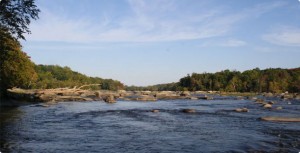This Saturday my friend visited from DC. As she is a passionate environmentalist and outdoorswoman, I was pleased the weather was cooperating in my plan to show off my city. Maybe it was the debate from class, but I felt a strange need to flaunt the James River Park System; the first indicator of how much my attachment and pride for Richmond has grown since she last visited a year ago. We walked to Pony Pasture. On the way we passed me and Jenni’s community garden plot on the Gamble Mill’s Trail, saw a snake swimming downstream from the Huguenot Bridge, and watched a group of kids pull an eel out of the water that was longer than my arm. As we wound our way down Riverside Drive, Kate kept commenting on the interconnectivity of the neighborhoods and the river; I think I realized for the first time how unique our city truly is.
In our debate I kept arguing that the James is representative of a fall zone because it runs through the middle of downtown Richmond. As Kate and I drove from Bikram on the other side of the river back to campus, then from the park to dinner in Carytown, I came to recognize the way my life in Richmond literally straddles the river. One really can walk from their front porch to the river, and as I’ve began to learn, everyone who claims to be a “true Richmonder” seems to have their own secret spot along the James to call their own. Last week I spent the night at my friend Amy’s. We woke up early and biked to Texas Beach before my 9am. We sat on a footbridge overlooking the canal and train tracks, the lush grasses below swaying in a current straight from UofR. I remember the first time I visited Belle Isle someone told me it is the best place to go if you want to see the demographics of RVA. Along the shore are the river rats that populate this city: from the aged fisherman to their grandchildren, the tourists and the first timers, each eddy-creating rock islands a human visitor. The various small parks scattered throughout the city feel like the hole-in-the-wall restaurants throughout the Fan; instead of Kaplan’s ideal of holding a sense of “away-ness”, they seem to sit firmly within our conception of our city and daily activity. It’s hard to perceive a wilderness/civilization duality when a river winds its way through our lives.
I think the seamless connectivity found in Richmond can undeniably be accredited to the leadership of Ralph White. Of course the river gets the real credit, but something about the rarity of Pipeline Park’s sliver of a presence along the Heron Rookery is magical. The park system really feels like our park system, and at times the units don’t even feel like parks at all; they’re just part of the city. When we bolted across 14th Street and slipped down a ladder to see the Heron Rookery, I remember feeling like I was seeing the undiscovered parts of RVA. Yet it only took a little looking around to realize we were under train tracks, fifty feet from sky scrapers and constantly being passed by punk kids, moms and reporters alike.
Although we have the privilege of such unequivocal connectivity, as Dr. Forsyth’s study showed, it’s hard for people to feel compelled to protect their watersheds if they’re not even aware they live in one. Before this course I had never heard the term “watershed” (or catchment, although I had heard basin without really knowing what it meant). The entire walk to Pony Pasture I was eagerly shouting out tree species and concepts from class, much to the esteem of my friend. When we got to the park, I was proud to see benches lining the river with plaques signed “Outdoor House”. I realized that having the river and the parks there is the start, but to actually understand the river’s beauty and problems requires more.
The James River Association’s report card provided me with a thorough understanding of the river, but for those who don’t seek it out, how do they find information? The answer: places like Earth Lodge. Our class is not solely about learning, it is a class that breeds environmental leaders. All of our final projects are based upon improving the connectivity our city has with its river. Through the almost libertarian (shall I dare label it?) approach of Ralph White, groups like Earth Lodge are able to make infrastructural improvements (such as shuttles literally taking people to the river or educational signs explaining campus’ relationship with its watershed). Without such, we cannot expect people to be informed, or for change to occur.
I am excited to leave Earth Lodge with a summer in Richmond ahead of me. Sharing a place with Jenni, Taylor and Thomas, I am certain we’ll find endless ways to apply our learning to our first apartment. Passing the community garden I could not help but notice its lack of rain barrels; as I sat on the banks of Pony Pasture I imagined every passing log as a sturgeon or manatee; and as we left, a decaying branch of a Sycamore was sprouting a new sapling.

